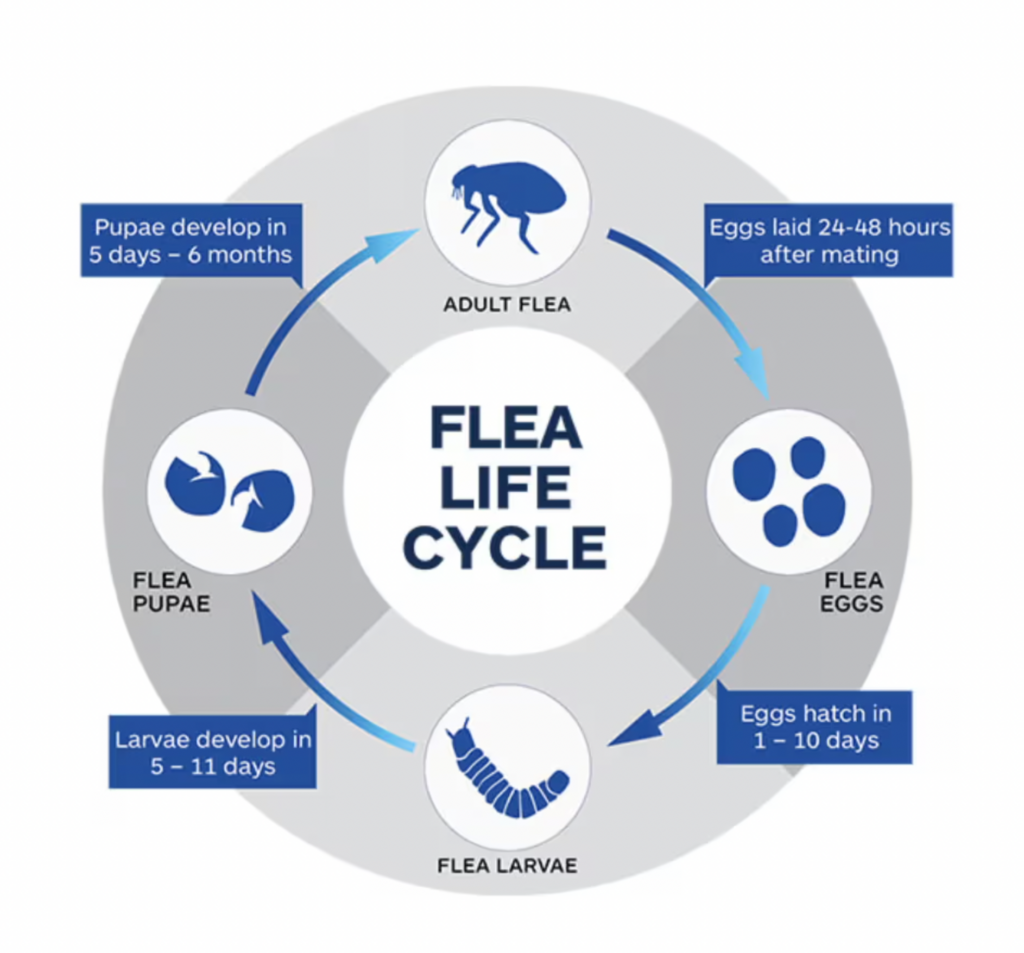Fleas are every pet parent’s nightmare, so flea treatment for dogs is a non-negotiable part of pet care. Not only are they icky, but flea bites often give our dogs itchy skin (flea bite dermatitis), and the scratching can lead to nasty secondary infections like hot spots. They also carry bacteria and parasites like tapeworms.
Not to mention, once a flea infestation takes over our home, the situation can soon feel overwhelming. So preventing flea infestations through consistently using a reliable tick and flea treatment for dogs is essential. With Pet Chemist, you also have the option of AutoShip to make sure you get your medicines on a schedule to avoid leaving your dog unprotected.
But while prevention is critical, many of us face a flea problem at some stage (especially if we have a habit of rescuing animals in need or live in rural areas). So, how do we know when we are dealing with fleas, and how do we deal with it?
What do dog fleas look like?
Dog fleas are dark and reddish-brown in colour, 1 to 3 mm in length, and have flattened bodies, allowing them to move quickly through their host’s fur. If your dog has them, you will typically see them hopping or crawling when you part the fur, specifically on the lower back, base of the tail, or groin area.
You should also see dark flecks (like coffee granules), which is called flea dirt. Flea dirt is flea faeces that the larvae feed on. Fleas go through four stages of development: egg, larva, pupa, and adult. You can see this article if you want to know about flea eggs.
You won’t be able to see the fleas that aren’t adults. Eggs, larvae, and pupae typically fall into places where the dog sleeps or frequents, like the carpet, bedding, or crevices on the floor or furniture. This is why a single flea treatment won’t work, as the fleas in other life stages are already in the environment, waiting to hatch.
Remember to treat all pets in your household, as fleas can quickly move from one host to another.
How do dogs get fleas?
Dogs can get fleas from other animals, such as cats, rodents, or any wildlife they encounter. They can also get them from an environment infested with fleas, such as by visiting a dog park or a kennel where another dog had fleas.
What kills fleas on dogs instantly?
Perhaps the fastest-acting dog flea treatment is Advantage, which kills adult fleas and larvae within 20 minutes and stops biting within 3 to 5 minutes. But it’s best to take several steps to kill fleas as fast as possible and stop an infestation in your home.

How to get rid of fleas on dogs:
If your dog has fleas, treating them as soon as possible is essential to prevent further flea and parasite infestations. You can follow these steps to get rid of fleas fast:
- Start by thoroughly cleaning your dog’s bedding, toys, and any other areas where your dog spends time. Wash everything in hot water and vacuum your home thoroughly to remove any fleas or flea eggs. Pay special attention to carpets and crevices in furniture and in the floor (especially wooden floors).
- Use a dehumidifier, as fleas need moisture in the air to survive.
- Wash your dog with flea shampoo like Fido’s Flea Shampoo or Permoxin Insecticide Rinse, as it kills fleas within 6 hours (but do not use this on cats as it can be toxic to them!)
- Next, use a flea comb to remove adult fleas from your dog’s fur. Be sure to comb your dog thoroughly, especially to areas such as the neck, tail, and belly.
- After removing adult fleas, it’s time to use a long-term flea treatment as part of your long-term regimen to prevent re-infestation. Choose a product appropriate for your dog’s size and weight, and follow the instructions carefully. Remember to treat all pets in your household, as fleas can quickly move from one host to another.
Choosing a dog flea treatment: What are your options?
Once you’ve gotten any immediate flea problem under control, your dog must be on a strict parasite control schedule for the rest of their life. This is vital to preventing future fleas on dogs (or other parasites). Treatment options include the following:
Topical flea treatments
Topical flea treatments, such as Neovet and Advantage, are applied directly to the dog’s skin and work by killing fleas on contact. Neovet has the benefit of also treating heartworm and intestinal worms in addition to fleas.
Flea collars
Flea collars need to be securely fitted to make sure they work correctly. However, collars like Seresto have the benefit of working against fleas for up to 8 months!
Oral medications
Oral medication is usually chewable tablets you can give your dog monthly. These work when fleas bite their host rather than on contact like the topical treatments. Popular options are:
- Bravecto 3-month chews have the benefit of protecting your dog for three months instead of one.
- Credelio Plus, Nexgard Trio & Simparico Trio all protect against intestinal worms, fleas, ticks, and heartworm for 30 days.
Flea sprays
Flea sprays are also available and can be applied directly to your dog’s coat. Fido’s Fresh Coat Spray works as a detangler and for long-term flea control.
You can read more in this article on top dog flea treatments to make an informed decision on the best option for your dog.
Flea treatment for dogs is essential for maintaining your dog’s health and well-being. Prevention is critical, and regular flea and tick treatments can help prevent infestations. If your dog does get fleas, it’s essential to act quickly and thoroughly clean your home and treat your pet to control parasites.
Flea lifecycle image courtesy of Nexgard
